Site menu:
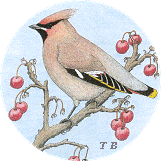
February 2017 Newsletter
Tracking Knots.
Colour Ring Report.
January Bird News.
Forthcoming Events.
Latest Newsletter.
Tracking Knots
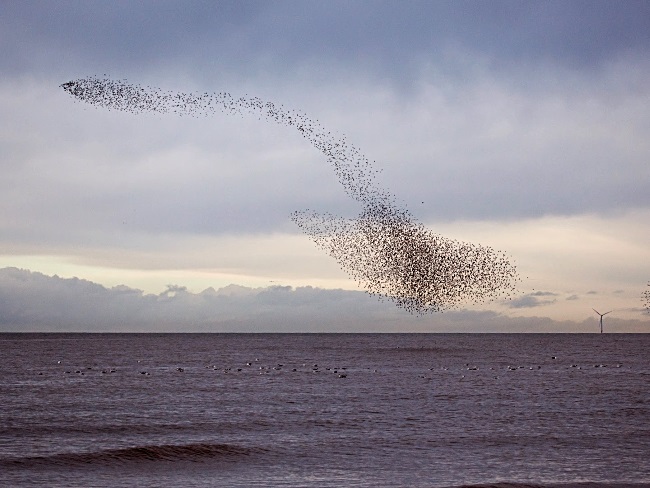
http://www.fromthemuddybanksofthedee.com/
I've always been fascinated by bird movements,
particularly waders. Knot are probably the archetypal species when it
comes to movements so when I was asked by Peter Knight, who has been
studying Knots on the Ribble estuary and Formby coast, to take part in
a coordinated tracking of Knot between the Dee, Formby and Ribble I
jumped at the chance. I recruited my fellow wader enthusiasts Matt
Thomas and Steve Hinde, who were also eager to take part. I'll let
Peter take up the story:
Two days earlier (13th Dec) the tide was lower at 9.6m and 16k roosted through the tide at Hoylake, but none were there or feeding at Thurstaston on the 14th; however 10k were feeding at Leasowe at low tide.
On 15th Dec all the Dee and Wirral Knot (totalling 17k: 7k at Meols and 10k flew by from further west - Hoylake) flew over to roost at Formby south (took them about 5 minutes to cross over), managing to roost just south of the warning sign for the rifle range, and there were 22k there in total at high tide (as counted when a Peregrine flushed them all during the falling tide). Ric had another flock of 9k that built up at Weld Road just around high tide, but he had none earlier on at Marshside and it isn’t clear where his birds were coming from – I didn’t see many/any going north prior to high tide. At high tide most birds at both sites were cruising around as drifting clouds up over the sea, but all landed at both sites once the tide began to fall. On the falling tide the Formby birds carried on roosting until I left about 4 hr after high tide; very few were found back on Wirral; Ric’s birds started feeding straight away and until he left the site – interestingly different behaviour. I wonder if his birds are relatively new (and hungry) arrivals from Waddensee.
So coordination worked easily and effectively, and showed a total of 31k Knot in the Ribble-Dee extended site on that date. Two weeks earlier, on the lower spring tide series, there were about 10k in the Dee and only about 1.2k on the Crosby-Ribble shore. So there looks to have been a big influx.
Peter Knight.
A
fascinating exercise. It confirmed what has been previously assumed,
that many of Dee estuary Knots on the highest tides fly all the way to
Formby/Alt estuary to roost. Interestingly, the 10k I saw flying past
me at Meols from the direction of Hoylake were not seen by
either
Steve or Matt who were monitoring from Thurstaston and Heswall
shore. It's possible they came all the way from Point of Ayr or,
perhaps,
had been in a sub-roost somewhere on East Hoyle Bank. In
addition
to the Knots described above Steve Hinde had 470 at Thurstaston before
high tide which flew over to Flint to roost. Perhaps with a future
coordinated count we should have observers both at Flint and Point of
Ayr as well, and one at Hilbre might be a good idea!
Many thanks to Peter Knight for organising this coordinated tracking of Knots and for letting me publish his account, and also Ric Else, Steve Hinde and Matt Thomas for taking part.
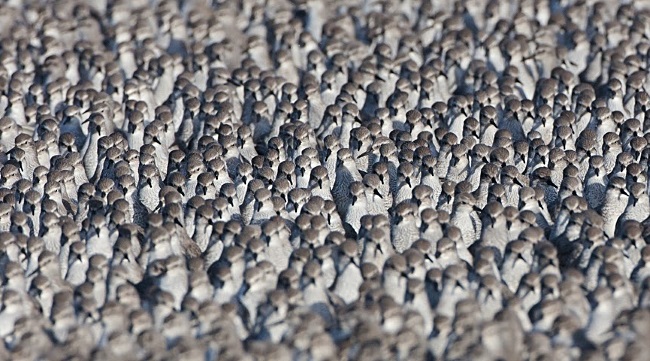
http://www.fromthemuddybanksofthedee.com/
A lot has been written about numbers and movements of Knot (and other wader species) around the Dee estuary and North Wirral, and also disturbance issues. Here is a list of some relevant articles:
1. J.R. Mitchell, M.E. Moser and J.S.
Kirby, Declines in midwinter counts of waders roosting on the Dee
Estuary, Bird Study (1988) 35, 191-198.
2. J.S. Kirby, C. Clee and V. Seagar, Impact and extent of recreational
disturbance to wader roosts on the Dee Estuary: some preliminary
results, Wader Study Group Bulletin, 68: 53-58, 1993.
3. K. Leeming, Wardening Waders, CAWOS Bird News Oct 99.
4. Richard Smith, WeBS and
Waders, May 2007 Newsletter,
http://www.deeestuary.co.uk/news0507.htm.
5. Richard Smith, North-west Estuaries
- Part 2 Knot and Dunlin, July 2010 Newsletter,
http://www.deeestuary.co.uk/news0710.htm.
6. Richard Smith, Knots on the Dee
Estuary 2012/13, October 2013 Newsletter,
http://www.deeestuary.co.uk/news1013.htm.
Richard Smith
Colour Ring Report
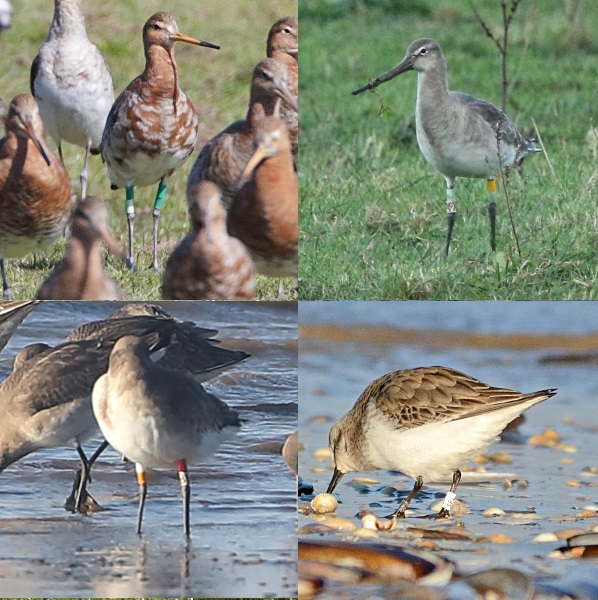
The main frustration about logging colour-ringed birds is not staring
at Black-tailed Godwits for hours wondering why they never move or not
being able to read the letters on a ring which is JUST too far away, no
- it's when you don't get feedback from the ringers! The norm is to get
a reply in a few days but when you have to wait several months it is
annoying and we are currently waiting for feedback for several gulls
and Black-tailed Godwits - no doubt there are good reasons for the
delay but it is still frustrating.
Despite that we have had a good few weeks with the continuing good
numbers of Black-tailed Godwits off Thurstaston and these provide
the bulk of records, plus a handful of gulls, a few small waders and an
Oystercatcher.
Black-tailed Godwits
28 colour-ringed Black-tailed Godwits were logged during December and January, a good total . In comparison December and January last winter saw just two! Here is a summary of four of them.GG-GL, ringed as an adult in eastern Iceland on May 3rd 2000.
Recorded on Thurstaston Shore three times in January 2017.
This bird has never been seen outside Iceland or the British Isles. Most years it spends the post-breeding period on the Humber Estuary, or other east coast sites whereas Ireland appears to be preferred in spring. It first appeared on the Dee estuary in January 2010 and became a regular here up until December 2013. Since then it has only been seen once anywhere, at Thurstaston in November 2014, before turning up in January this year. I wonder where it's been?
YL-LX, ringed as an adult in north-west Iceland on July 14th 2012.
Recorded at Gilroy Scrape and Thurstaston shore four time in January 2017.
The first record after ringing was in September 2012 at Burton Mere Wetlands and, apart from a single record back in Iceland and two in Dublin, has never been recorded away from north-west England/north Wales.
R8-WO, ringed as an adult male in northern Iceland on July 15th 2010.
Recorded on Thurstaston Shore 11 times during December 2016 and January 2017.
First record after ringing was at Thurstaston shore in December 2010 and it spent the winter there. July and August 2012 saw it at the famous Cley Reserve in Norfolk. It spent April 2013 at the Caldy Wildfowl Collection field (by the Dee estuary) and was seen back in Iceland that summer. On June 25th 2014 it was on the island of Islay (Hebrides) implying that it didn't breed that year. But the following summer it was back in Iceland. It wasn't recorded at all in the winter of 2015/16 but April 2016 saw it at Leighton Moss. It was recorded throughout May and June at Siglufjörður in northern Iceland so it was presumably breeding there. July saw it back in Cley and it was next seen at Caldy in October before moving north to Marshside, Southport, in November. It returned to Thurstaston Shore on December 1st 2016.
OL-RZ, (Z is letter Z on orange ring), ringed as an adult male in south-west Iceland on July 4th 2012.
Recorded at Thurstaston Shore six times in the second half of January 2017.
This bird is mostly recorded on the Blackwater and Thames Estuaries but only in late winter/early spring and in August. Until this year's records at Thurstaston it has never been seen in mid-winter. The only other record from the Dee estuary was when it was at Gilroy in November 2014.
Knots
Y flag with letters PAA - R.Ringed at Brenna in Porsanger Fjord, northern Norway, on May 26th 2013, during spring migration.
Recorded at Thurstaston on January 5th 2017.
The only other record was at Southport (seen by Peter Knight, see above 'Tracking Knots' article), on August 14th 2016.
L6GLYY (if you wish to understand the code for Dutch ringed knot download a PDF file here.)
Ringed at De Richel island on the Waddensea, Netherlands, on August 31st 2011.
Recorded on Thurstaston shore on December 28th 2016.
First record after ringing was in Holme, Norfolk, in October 2011. It was back on the Waddensea in October 2012. January 2013 saw it on Hoylake shore and it was back again on the Waddensea in September 2016.
Oystercatcher
NG-GflagG. Ringed as a chick on the north-western tip of Iceland on June 30th 2013 where it was seen feeding a month later.Recorded on Heswall Shore on January 24th 2017, no other records.
Dunlin
5PL - black on white ring. Most of our Dunlin records come from the scheme in Poland where they are ringed near Gdansk and this is one of them. We are still waiting for details for this bird.Recorded at Leasowe Bay on December 29th 2016.
Herring Gull
T:334, black on yellow ring.Ringed as a chick at Old Slains, Aberdeenshire (north of Aberdeen) on June 29th 2012, by our friends the Grampian Ringing Group.
Recorded on Hoylake shore on December 13th 2016, no other records.
Black-headed Gull
4HM, black on white ring.Ringed in Copenhagen on March 28th 2015.
Recorded at New Brighton on March 5th 2016 and January 22nd 2017.
Richard Smith.
Colour-rings were also reported by Matt Thomas, Steve Hinde, Colin Schofield, Richard Beckett, Tim Kinch, Elliot Monteith, William Boyce and John Jakeman.
Top of Page
January Bird News
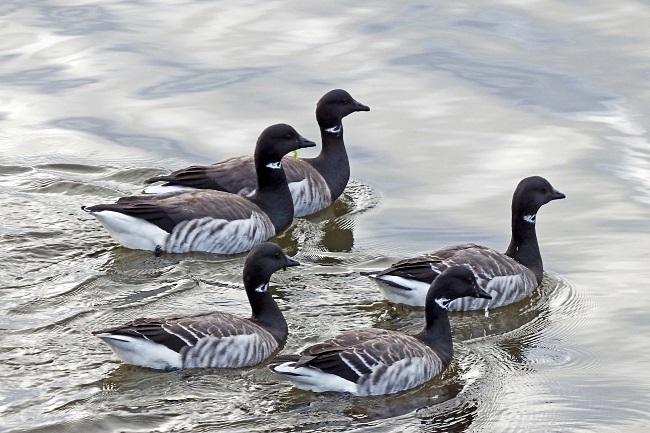
There were two good counts of Brent Geese during the month with 298 off Hilbre on the 14th (a record high for the island) and 290 on West Kirby Shore on the 16th. As for last month small numbers were seen several times on West Kirby Marine Lake giving some great opportunities for photographs. Two Goosanders were present there almost every day, I don't remember any other year when we have had over-wintering Goosanders on the estuary. Up to two Long-tailed Ducks and five Scaup were off-shore.
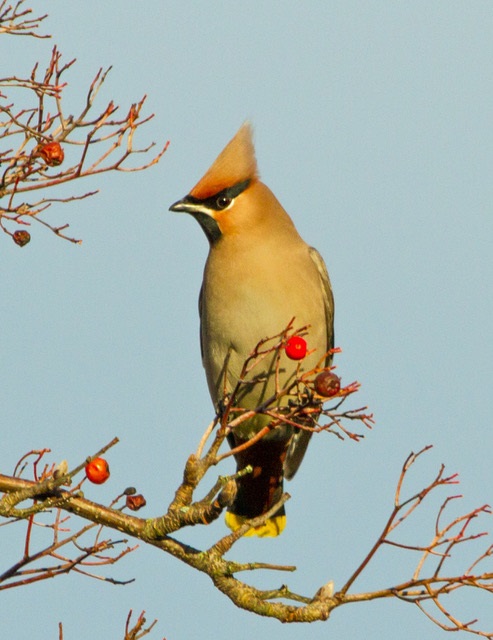
There were a few reports of Waxwings through the month but it wasn't until the 27th that we got a settled flock with up to 29 staying until the end of the month in Heswall.
Wader numbers haven't been particularly big this winter but there have been around 3,000 Black-tailed Godwits at Thurstaston, in the cold wind they were a spectacular sight feeding close to the beach completely unafraid of passing walkers. Also there were 370 Bar-tailed Godwits. 18 Purple Sandpipers at New Brighton was an excellent count on the 14th, it was during strong winds and may well include birds normally on Hilbre.
On the marshes we have had two male Hen
Harriers and at least two
ringtails. Three Marsh Harriers were seen regularly and there were
reliable reports of numbers in double-figures coming into roost in the
reed beds - remarkable when you think one over-wintering Marsh Harsh
was a rare event just a few years ago. Five Great White Egrets were
present at Burton Mere Wetlands on the 11th and there was a Cattle
Egret there on the 25th. On the same date four Water Pipits were in the
Neston Old Quay area. The Connah's Quay Nature Reserve remains by far
the most important site on the estuary for Twite with at least 60
recorded.
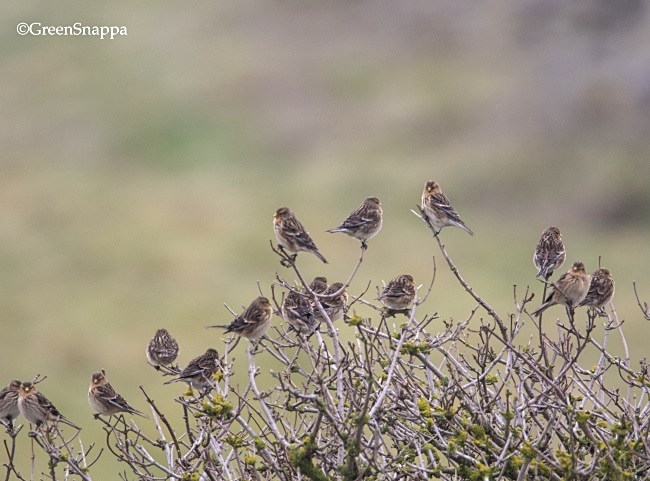
Top of Page
What to expect in February
Another sign of spring will be the return of large flocks of Common Scoters to Liverpool Bay, pausing here for a few weeks before moving north. With them could well be a Surf Scoter or two, also out there we can expect several hundred Great Crested Grebes with, hopefully, a selection of rarer grebes and sea ducks.
Usually in February we can expect a high spring tide but the forecast heights are disappointing this year and it would take a westerly gale to blow the sea over the marsh at Parkgate. Nevertheless, the over-wintering Marsh and Hen Harriers will still be around, as well as a few Short-eared Owls. There will also be several thousand Pink-footed Geese and may be we will break another record - it currently stands at 8,900 (Feb 2016) so may be 10,000+!!
There is still plenty of time for some cold winter weather and we can expect plenty of waders to still be here, such as Dunlin, Knot and both Bar-tailed and Black-tailed Godwits. The lower spring tides might well mean that we get some big wader roosts at Hoylake.
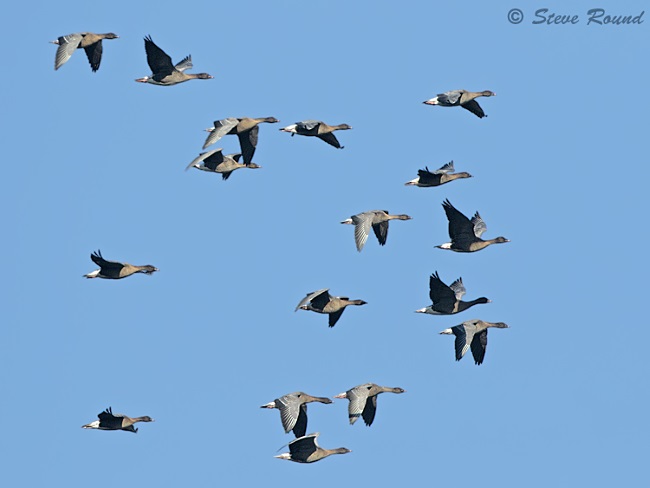
http://stevenround-birdphotography.com/
Top of Page
Forthcoming Events
February Highest Spring Tides (Liverpool)
Also
see Tides
page.
11th February, 11.21hrs (GMT), 9.6m.
12th February, 12.03hrs (GMT), 9.7m.
13th February, 12.40hrs (GMT), 9.6m.
Forthcoming Events
Organised by the Wirral
Ranger Service , Flintshire
Countryside Service and the
RSPB (Dee Estuary):
All these events and walks have bird interest, even those not
advertised specifically for birdwatching. No need to book for these
events unless specified - please check below.
Saturday
4th February, 9am to 1pm, Birdwatching Walk to Hilbre.
Join the Wirral Rangers and the RSPB on a guided walk to Hilbre Island
at low tide.
We
will walk to the islands to look for the birds that make Hilbre their
home during the winter months. Hopefully we will connect with Brent
Geese and Purple Sandpipers as well as the usual variety of waders and
wildfowl present on the islands.
Booking essential:
places limited, email deeestuary@rspb.org.uk or
ring 0151 353 8478. £5
per person.
Bring binoculars and wear warm waterproofs.
Saturday 11th
February, 1000am to 12.30pm, High Tide Birdwatch at Hoylake.
Join
the Coastal Rangers, the Dee Estuary Voluntary Wardens and the RSPB on
this high tide birdwatch at Hoylake to see large numbers of waders as
they gather and roost on the shore.
With a rising tide, we
should see the birds at close quarters as they roost and
feed.
Beginners welcome. Dress warmly and bring binoculars if you
have
them.
There is no need to book. High tide is at 11.21hrs and height 9.6m.
Meet at King’s Gap, King’s Parade, Hoylake.
For further information please telephone Wirral Country Park on (0151)
648 4371.
Sunday 26th
February,
Raptor Watch at Parkgate.
1pm to dusk.
Join
us for a chance to see up to seven different birds of prey including
peregrine and merlin, plus two types of owl that all make their home on
the RSPB Dee Estuary nature reserve. With its panoramic views of the
saltmarsh, Parkgate is one of the best places to watch for the birds
hunting.
Stick around until dusk for a chance to see the graceful
and endangered hen harriers flying into roost for the night on the
marsh close to the Old Baths car park, plus a ghostly barn owl emerging
to hunt.
No booking required, come along any time between 1 pm and
sunset. Dress appropriately for the weather and don't forget your
binoculars! Public toilets and various pubs and cafes are situated
close by along Parkgate promenade.
Ring 0151 353 8478 for further details.
Directions
The Old Baths car park, Parkgate (just north of The Boathouse pub).
Saturday
4th March, 9am to 1pm, Birdwatching Walk to Hilbre.
Join the Wirral Rangers and the RSPB on a guided walk to Hilbre Island
at low tide.
We
will walk to the islands to look for the birds that make Hilbre their
home during the winter months. Hopefully we will connect with Brent
Geese and Purple Sandpipers as well as the usual variety of waders and
wildfowl present on the islands.
Booking essential:
places limited, email deeestuary@rspb.org.uk or
ring 0151 353 8478. £5
per person.
Bring binoculars and wear warm waterproofs.
Sunday 26th
March,
Raptor Watch at Parkgate.
1pm to dusk.
Join
us for a chance to see up to seven different birds of prey including
peregrine and merlin, plus two types of owl that all make their home on
the RSPB Dee Estuary nature reserve. With its panoramic views of the
saltmarsh, Parkgate is one of the best places to watch for the birds
hunting.
Stick around until dusk for a chance to see the graceful
and endangered hen harriers flying into roost for the night on the
marsh close to the Old Baths car park, plus a ghostly barn owl emerging
to hunt.
No booking required, come along any time between 1 pm and
sunset. Dress appropriately for the weather and don't forget your
binoculars! Public toilets and various pubs and cafes are situated
close by along Parkgate promenade.
Ring 0151 353 8478 for further details.
Directions
The Old Baths car park, Parkgate (just north of The Boathouse pub).